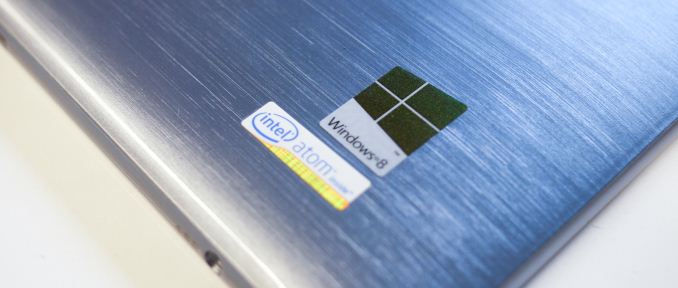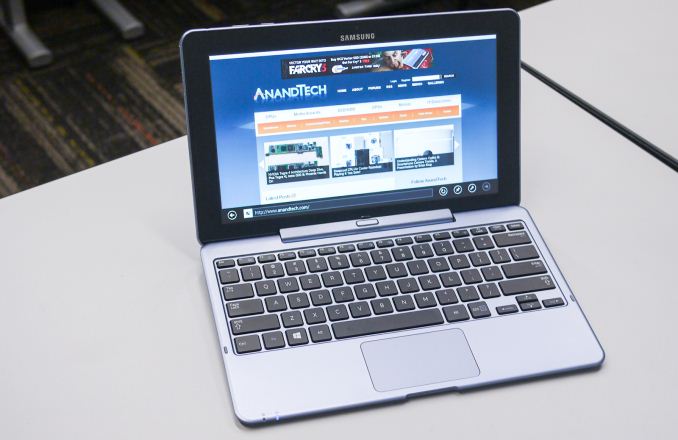Samsung ATIV Smart PC: Revisiting Clover Trail Convertibles
by Vivek Gowri on March 18, 2013 12:00 AM ESTConcluding on Clover Trail for Windows
I used the ATIV Smart PC as my main system on the CES show floor. It worked out relatively well, though part of that was due to the fact that I didn’t actually spend much time using it there. My CES scheduling this year ended up in back-to-back-to-back meetings for a large portion of my three days there. Much of my writing ended up being done back in the hotel room where I had my trusty Samsung Series 7 Chronos to rely on. But honestly, the ATIV was pretty solid. I had relatively modest expectations for it on the way in—“last all day, give me a solid writing tool, and run Lightroom so I can publish decent posts on the go.” That’s what I said I wanted out of it in the CES gear article I posted in Pipeline the day I left, and the ATIV did all I asked of it with nary a complaint or hiccup in the process.
As I type this, my roommate is sitting behind me playing StarCraft II on the ATIV Smart PC, albeit rather slowly. And honestly, that’s the story for me with Clover Trail. You really get the best of both worlds with regards to PC application compatibility and battery life. Performance, at times, can be a bit pokey, particularly on the GPU side of things. But Clover Trail really brings all day computing to the world of x86 tablet PCs. It isn’t the fastest or most interesting SoC in the world. But in a mobile companion, if having 10 hours of battery life matters, you cannot beat the Clover Trail/Windows 8 combination as a tablet platform. It’s just so much more versatile than iOS or Android in terms of replacing a small notebook, and when you factor in the battery life parity that we see in Clover Trail, that’s a legitimately valuable proposition.
Just based on pricing, it becomes quickly evident that the Atom-based tablets offering the best value right now are the ATIV Smart PC and ASUS’ VivoTab Smart. You can get either in 64GB form in the $500-550 range, making them cheaper than most Windows RT devices offering equal amounts of storage space (though it’s worth mentioning that you can get a VivoTab RT for less than $400 pretty readily). As a value proposition, you have to think about it—would you rather pay $499 for a 16GB iPad, a 32GB Nexus 10, or a full fledged Windows Tablet PC with ~35GB of unused storage space? Put in terms like that, it’s pretty awesome.
The ATIV Smart PC is a decent tablet, and taken on its own it’s a good device. But there are some really key missteps that were made with the hardware—design, build quality, and display. Given the cost and overall usability of the device, it’s possible to overlook these flaws, but the comparison to the VivoTab Smart is where the ATIV Smart PC starts to fall down. The ASUS has a nicer 10.1” form factor with a better display, along with better styling and build quality. The ATIV does have one trump card—the active digitizer. Other than that, the 10.1” VivoTab Smart is just a better piece of hardware, more elegant and nicer to use. Honestly, unless you really want the Wacom digitizer, you’re better off going the direction of the ASUS.












59 Comments
View All Comments
Snotling - Tuesday, March 19, 2013 - link
I don't know... what's the battery life on a Samsung GS4?Snotling - Monday, March 18, 2013 - link
On a 11.6" display... Samsung! They have more pixels on their 5" smartphones.(GS4)MrSpadge - Monday, March 18, 2013 - link
Yeah, at that resolution and size you don't even have to fiddle with font sizing to read stuff. How dare they offer this!powerarmour - Monday, March 18, 2013 - link
That is definitely a competitive problem, I saw the screen on a Nexus 10 the other day... Wow!ab_aditya - Monday, March 18, 2013 - link
A small correction - the iPad storage now goes up to 128 GBVivekGowri - Monday, March 18, 2013 - link
Thanks for catching that - copied out of an old table and missed to update. Fixed.augustofretes - Monday, March 18, 2013 - link
Will you review the Chromebook Pixel? It looks beautiful. And for a Linux user as myself it seems like a perfect device.PC Perv - Monday, March 18, 2013 - link
Nexus 10 is $399+. I don't know why AT keeps getting it wrong while going extra miles to find the cheapest prices for Atom-based tablets.And while this may be somewhat of a moot point, Nexus 10 drives 2560x1600 while these Atom tablets are 1366x768, and they use similar sized batteries. Considering that screen time is probably responsible for 80~90% of battery life of these mobile devices, don't you think a bit more explanation is warranted in your battery tests?
evonitzer - Monday, March 18, 2013 - link
Indeed. I clicked on the link provided in the price comparison and it took me to Amazon where it is priced as indicated. Buy it directly from Google! Their price is always at $399 for the 16 GB version.I'm not sure Microsoft deserves the blame you assign them for their naming scheme. Windows Surface with RT and Windows Surface with Windows 8 Pro are names that exactly describe what they are. Once you get the distinction between RT and 8 Pro, it's very straightforward. It's better that they don't try to come up with a catchy name that rolls off the tongue but instead name their products exactly as they are. If Samsung followed the Microsoft example, they would call them Samsung Ativ 10.1 Windows RT and Samsung Ativ 11.6 Windows 8 Pro. Hideous names yes, but very clear.
VivekGowri - Monday, March 18, 2013 - link
That's odd, I didn't realize it said $462+, it should definitely be $399 on the Nexus 10. Fixed.